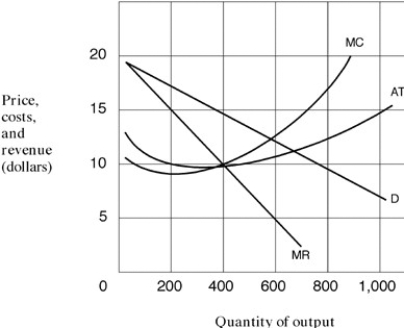A) this firm is making a normal profit.
B) other picture-frame companies will want to exit the market.
C) there are no other picture-frame companies in the area.
D) economic profits are $1500.
E) total profits are being maximised.
Correct Answer

verified
Correct Answer
verified
Multiple Choice
A kinked demand curve reflects a tendency on the part of an oligopolist to do which of the following?
A) Follow price increases but not price reductions.
B) Follow price reductions but not price increases.
C) Be unconcerned with rivals' behaviour.
D) None of the above.
Correct Answer

verified
Correct Answer
verified
Multiple Choice
Both homogeneous and differentiated product can be found in which market?
A) Perfect competition.
B) Oligopoly.
C) Monopolistic competition.
D) Monopoly.
Correct Answer

verified
Correct Answer
verified
Multiple Choice
A major characteristic of the theory of oligopoly is:
A) that there are no real-world examples.
B) that the firms are interdependent in their decisions.
C) that, in reality, few oligopolies survive more than 10 years.
D) that the firms are independent in their decisions.
Correct Answer

verified
Correct Answer
verified
Multiple Choice
A monopolistically competitive market is characterised by:
A) many firms and consumers with differentiated products.
B) a single seller of a product that has few suitable substitutes.
C) very strong barriers to entry.
D) mutual interdependence in pricing decisions.
Correct Answer

verified
Correct Answer
verified
Multiple Choice
Narrbegin Exhibit 9.1 A monopolistic competitive firm  -As presented in Exhibit 9.1, the short-run profit per unit of output for the monopolistically competitive firm is:
-As presented in Exhibit 9.1, the short-run profit per unit of output for the monopolistically competitive firm is:
A) zero.
B) $5.
C) $10.
D) $15.
Correct Answer

verified
Correct Answer
verified
Multiple Choice
The short-run equilibrium for a monopolistically competitive firm is at P = $28.47, ATC = $22.13 and MC = MR = $17.47. Which of the following is true?
A) Per-unit profit is $11.
B) Additional firms will be attracted into the industry.
C) The firm could raise price and increase profits.
D) The firm could lower price and increase profits.
Correct Answer

verified
B
Correct Answer
verified
Multiple Choice
In monopolistic competition, profit:
A) is proof that advertising works.
B) motivates existing firms to increase prices.
C) signals for new firms to enter.
D) provides a motive for existing firms to decrease prices.
Correct Answer

verified
C
Correct Answer
verified
Multiple Choice
It is difficult to talk conclusively about the allocation of resources in an oligopoly because:
A) entry is impossible in oligopolies.
B) both price and output can be higher in oligopolies than in perfect competition.
C) the level of competition varies greatly in oligopolistic markets.
D) non-price competition is rare in an oligopoly.
Correct Answer

verified
Correct Answer
verified
Multiple Choice
The oligopoly market structure does not have which of the following characteristics?
A) Few sellers.
B) Homogeneous product.
C) Differentiated product.
D) Many small sellers.
Correct Answer

verified
Correct Answer
verified
Multiple Choice
Mutual interdependence means that:
A) firms always work together in an oligopoly.
B) firms need the help of other firms to make an economic profit.
C) firms in an oligopoly must consider the actions of the other firms when making strategic decisions.
D) collusion always occurs in an oligopoly.
Correct Answer

verified
C
Correct Answer
verified
Multiple Choice
Compared to monopoly, the market results with monopolistic competition are usually expected to be:
A) worse because consumers get fewer choices.
B) worse because consumers pay a higher price.
C) the same.
D) better because consumers pay a lower price.
Correct Answer

verified
Correct Answer
verified
Multiple Choice
Oligopoly is a market structure characterised by:
A) barriers to enter and mutual interdependence.
B) barriers to exit and independent pricing decisions.
C) lack of control over prices.
D) a differentiated product and independent decisions.
Correct Answer

verified
Correct Answer
verified
Multiple Choice
Costume jewellery is produced in a monopolistically competitive market. One producer finds that MR = MC = $3 when output is 700 necklaces. An economist studying this information can conclude that:
A) the producer is charging a price of $3.
B) economic profit is $2100.
C) the producer charges a price greater than $3.
D) new firms will want to enter.
Correct Answer

verified
Correct Answer
verified
True/False
Firms in monopolistic competition are price takers.
Correct Answer

verified
Correct Answer
verified
Multiple Choice
The model of monopolistic competition is:
A) a combination of monopoly and competition.
B) the same as a model of monopoly.
C) the same as a model of perfect competition.
D) unlike other models.
Correct Answer

verified
Correct Answer
verified
Multiple Choice
The monopolistic competition market structure is characterised by:
A) many small firms and an easy market entry and exit.
B) many firms and consumers with differentiated products.
C) many small firms and a homogeneous product.
D) few firms and a homogeneous product.
Correct Answer

verified
Correct Answer
verified
Multiple Choice
A kinked demand curve is perceived by the firm as being:
A) more elastic to the right of the kink.
B) more inelastic to the right of the kink.
C) more inelastic to the left of the kink.
D) present when there is a monopoly.
Correct Answer

verified
Correct Answer
verified
Multiple Choice
Product differentiation:
A) refers to the attempt by firms to make their products look like those of the other firms in the industry.
B) refers to the attempt by firms to make essentially substitutable products look different in the minds of the consumers.
C) refers to the advantage big firms have in research and development.
D) is a common characteristic of a perfectly competitive market structure.
Correct Answer

verified
Correct Answer
verified
Multiple Choice
In the long run in monopolistic competition:
A) economic profits are zero.
B) P = MC.
C) P = minimum ATC.
D) firms have an incentive to leave.
Correct Answer

verified
Correct Answer
verified
Showing 1 - 20 of 124
Related Exams